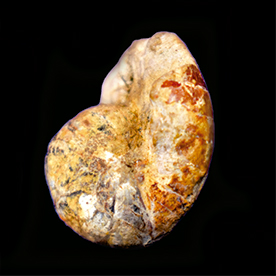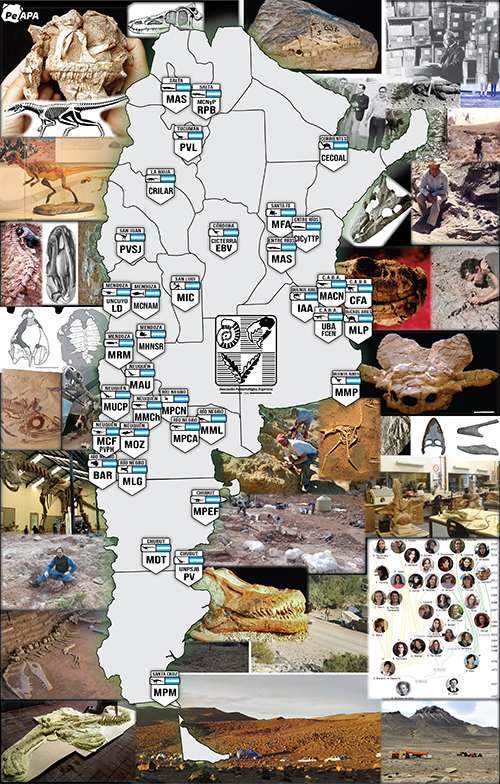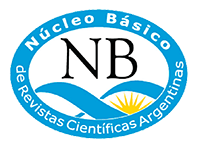EOCENE NAUTILOIDS FROM THE BAJA CALIFORNIA PENINSULA, MEXICO: RECORDS, DESCRIPTION OF A NEW SPECIES, AND BIOGEOGRAPHIC IMPLICATIONS
DOI:
https://doi.org/10.5710/PEAPA.17.09.2023.463Keywords:
Cephalopoda, Ypresian, Nautilus, Tepetate Formation, NautilidaeAbstract
Several cephalopods from the Eocene have been recorded along the Pacific coast of North America. Each new record incorporates relevant knowledge to infer the paleobiology of this group. In this study, we report two nautiloids (subclass Nautiloidea) from the Ypresian found in the Tepetate Formation. One specimen was identified as Eutrephoceras hannai, and the other was designated as species nova, Nautilus sudcalifornianus. We found that the suture shape, especially in the lateral lobe, is the most conspicuous diagnostic feature to discriminate nautiloids. Moreover, the biological material evaluated in our study constitutes the southernmost geographic distribution of the two species and the most ancient record of Nautilidae for the Eocene. Due to the characteristics detected in the specimens analyzed here and previous studies that describe the faunal diversity of the formation, we hypothesize that this area was an idoneous site for spawning and growth of young stages of E. hannai and N. sudcalifornianus sp. nov. during the Eocene. Thus, our study supports the hypothesis that extant nautiloids migrate towards warm shallow water areas for spawning and growth of the juvenile stage and suggests that this migratory behavior is ancient within the subclass. With this research, we provide new insights into the taxonomy, biology, ecology, and biogeography of nautiloids from the Eocene. Additionally, the Tepetate Formation has great geological and paleontological relevance given the faunal diversity discovered in this area increases the malacological record for the northeastern Pacific.
References
Agassiz, L. (1847) Lettre sur quelques points de'organisation des animaux rayonnes. Comptes rendus, 25, 677–682.
Anderson, F. M., & Hanna, G. D. (1935). Cretaceous geology of lower California. Proceedings of the California Academy of Sciences, 23, 1–34. https://biostor.org/reference/78349
Blainville, H. M. D. de. (1825-1827). Manuel de malacologie et de conchyliologie. Paris, Levrault 1-647 [1825], 649-664 + 109 pl. [1827]. http://www.biodiversitylibrary.org/item/43891
Chirat, R. (2000). The so-called “cosmopolitan” palaeogeographic distribution of Tertiary Nautilida of the genus Aturia Bronn 1838: the result of post-mortem transport by oceanic palaeocurrents. Palaeogeogeography, Palaeoclimatology, Palaeoecology, Elsevier, 157(1–2), 59–77. https://doi.org/10.1016/S0031-0182(99)00150-9
Coleman, T. A. (1979). Nannoplankton biostratigraphy of the Tepetate Formation, Baja California Sur, México [Doctoral dissertation, University of Southern California, United States of America).
Cuvier, G. 1795. Second Mémoire sur l'organisation et les rapports des animaux à sang blanc, dans lequel on traite de la structure des Mollusques et de leur division en ordre, lu à la société d'Histoire Naturelle de Paris, le 11 prairial an troisième. Magazin Encyclopédique, ou Journal des Sciences, des Lettres et des Arts, 1(2), 433-449. http://www.biodiversitylibrary.org/page/6736775.
Dunstan, A. J., Ward, P. D., & Marshall, N. J. (2011). Nautilus pompilius life history and demographics at the Osprey Reef Seamount, Coral Sea, Australia. PLoS ONE 6(2): e16312). https://doi.org/10.1371%2Fjournal.pone.0016312
Fletcher, J. M., Grove, M., Kimbrough, D., Lovera, O., & Gehrels G. E. (2007). Ridge-trench interactions and the Neogene tectonic evolution of the Magdalena shelf and southern Gulf of California: Insights from detrital zircon U-Pb ages from the Magdalena fan and adjacent areas. GSA Bulletin, 119(11-12): 1313–1336. https://doi.org/10.1130/B26067.1
Fulwider, R. W. (1976). Biostratigraphy of the Tepetate Formation Baja California Sur [Master Thesis. University of Southern California, United States of America]. Recuperado de https://searchworks.stanford.edu/view/4544996
Galli-Oliver, C. T., Márquez-Enriquez, T. E., Reyes-Sarabia, J. A., & Rosas-Cortés, C. (1986). Estructuras sedimentarias primarias y litofacies de corrientes densas de un paleoambiente de talud, El Conejo, Baja California Sur, México. Ciencias Marinas, 12, 7–15. http://dx.doi.org/10.7773/cm.v12i2.513
García-Cordero, E., & Carreño, A. L. (2009). Upper lower Eocene calcareous nannoplankton from the Las Pocitas core (Tepetate formation), Baja California Sur, Mexico. Revista Mexicana de Ciencias Geológicas, 26(1): 37–47. http://www.redalyc.org/articulo.oa?id=57214935004
Goedert, J. L., & Kiel, S. (2016). A lower jaw of the nautiloid Aturia angustata (Conrad, 1849) from Oligocene cold seep limestone, Washington State, U.S.A. PaleoBios, 33: 1–6. https://doi.org/10.5070/P9331032868
Goedert, J. L., Kiel, S., & Tsai, C. H. (2022). Miocene Nautilus (Mollusca, Cephalopoda) from Taiwan, and a review of the Indo-Pacific fossil record of Nautilus. Island Arc, 31(1), 1–9. https://doi.org/10.1111/iar.12442
González-Barba, G. (2002). Descripción de asociaciones faunísticas de elasmobranquios fósiles del Eoceno Superior (Priaboniano) de las Formaciones Tepetate y Bateque de Baja California Sur, México [Tesis de Maestría, Centro Interdisciplinarios de Ciencias Marinas, Instituto Politécnico Nacional, México]. Recuperado de http://www.repositoriodigital.ipn.mx/handle/123456789/14650
Halder, K. (2012). Cenozoic fossil nautiloids (Cephalopoda) from Kutch, western India. Palaeoworld, Elsevier, 21(2), 116–130. https://doi.org/10.1016/j.palwor.2012.05.004
Heim, A. (1922). Notes on the Tertiary of Southern Lower California (México). Geological Magazine, 59(XII), 529–547. https://doi.org/10.1017/S0016756800109069
Hickman, C. J. S. (1969). The Oligocene marine molluscan fauna of the Eugene Formation in Oregon. University of Oregon, Museum of Natural History Bulletin, 16, 1–112.
House, M. (1987). Geographic distribution of Nautilus shells. In W. B. Saunders, & N. H. Landman (Eds.), Nautilus, the Biology and Paleobiology of a Living Fossil (pp. 53–64). Plenum Press, New York.
Kummel, B. (1956). Post-Triassic nautiloid genera. Bulletin of the Museum of Comparative Zoology at Harvard College, 114, 324–494.
LeBlanc, J. (2019). Identification of the Middle Eocene Nautiloid Genera of Qatar, Middle East. [Technichal Report]. Recuperado de http://dx.doi.org/10.13140/RG.2.2.28135.09125
Linnaeus, C. (1758). Systema Naturae per regna tria naturae, secundum classes, ordines, genera, species, cum characteribus, differentiis, synonymis, locis. Laurentius Salvius: Holmiae, Editio decima, reformata (pp. 824). https://biodiversitylibrary.org/page/726886.
Marín, F., & Luquet G. (2004). Molluscan shell proteins. Comptes Rendus Palevol, Elsevier, 3(6-7), 469–492. https://doi.org/10.1016/j.crpv.2004.07.009
Miller, A. K. (1947). Tertiary nautiloids of the Americas. Geological Society of America Memoir, 23, 1–234. https://doi.org/10.1130/MEM23
Miller A. K., & Downs, H. R. (1950). Tertiary nautiloids of the Americas: supplement. Journal of Paleontology, 24(1), 1–18. http://www.jstor.org/stable/1299723.
Mina-Uhink, F. (1957). Bosquejo geológico del territorio sur de la Baja California. Boletín de la Asociación Mexicana de Geólogos Petroleros, 9(3), 139–270.
Miranda-Martínez, A. Y., & Carreño, A. L. (2008). Foraminíferos de la Formación Tepetate (Heim) en el área de Las Pocitas, Baja California Sur, México. Ciencias Marinas. 34(2), 179–195. http://dx.doi.org/10.7773/cm.v34i2.1317
Morales-Ortega, P. (2010). Registro de las asociaciones faunísticas de invertebrados en la Formación Tepetate (Paleoceno-Eoceno) en Baja California Sur, México. [Tesis de Licenciatura en Biología Marina, Universidad Autónoma de Baja California Sur, México]. Recuperado de http://biblio.uabcs.mx/tesis/te2369.pdf
Morales-Ortega, P. (2012). Correlación paleontológica de macroinvertebrados en las formaciones Tepetate y Bateque (Paleoceno – Eoceno) en Baja California Sur, México. [Tesis de Maestría, Centro Interdisciplinarios de Ciencias Marinas, Instituto Politécnico Nacional, México]. Recuperado de http://tesis.ipn.mx/handle/123456789/18366
Morales-Ortega, P., & González-Barba, G. (2018). Gasterópodos marinos de la Formación Tepetate, Baja California Sur, México. Paleontología Mexicana, 7(2), 81–96.
Morales-Ortega, P., González-Barba, G., Nava-Sánchez, E. H., & Vera-Dimas D. (2015). New Early Eocene Echinoids from Baja California Sur, Mexico. Paleontología Mexicana, 4(1), 12–23. http://dx.doi.org/10.13140/RG.2.2.20534.16960
Morales-Ortega, P., González-Barba, G., Nava-Sánchez, E. H., & Vera-Dimas, D. (2016). New Eocene bivalves from Bateque Formation, Baja California Sur, Mexico. Paleontología Mexicana, 5(1), 1–19.
Palmer, K. V. W. (1961). A new nautiloid, Eutrephoceras eyerdami, new species from the Cowlitz Formation, upper Eocene, of Washington. Journal of Paleontology, 35, 532–534. http://www.jstor.org/stable/1301133.
Perrilliat, M. C. (1996). Ocurrence of the Tethyan Gastropods Campanile and Gisortia in the Lower Eocene Part of the Tepetate Formation, Baja California Sur, México. The Veliger, 39(2), 178–183.
Reyment, R. A. (2008). A Review of the post-mortem dispersal of Cephalopod shells. Palaeontologia Electronica, 11(3), 12A–13p. http://palaeo-electronica.org/2008_3/148/index.html
Rocha, F., Guerra, Á., & González, Á. F. (2001). A review of reproductive strategies in cephalopods. Biological Reviews of the Cambridge Philosophical Society, 76(3), 291–304. https://doi.org/10.1017/S1464793101005681
Schweitzer, C. E., Feldmann, R. M., González-Barba, G., & Vega, F. (2002). New crabs from the Eocene and Oligocene of Baja California Sur, México and an assessment of the evolutionary and paleobiogeographic implications of mexican fossil decapods. Memoir, The Paleontological Society, 59(6), 1–43. http://www.jstor.org/stable/1315632
Schweitzer, C. E., González-Barba, G., Feldmann, R. M., & Waugh, D. A. (2005). Decapoda (Thalassinidea and Paguroidea) from the Eocene Bateque and Tepetate Formations, Baja California Sur, México: systematics, cuticle microstructure, and paleoecology. Annuals of Carnegie Museum, 74(4), 275–293. https://doi.org/10.2992/0097-4463(2005)74[275:DTAPFT]2.0.CO;2
Schweitzer, C. E., Feldmann, R. M., González-Barba, G., & Cosovic, V. (2006). New Decapoda (Anomura, Brachyura) from the Eocene Bateque and Tepetate Formations, Baja California Sur, México. Bulletin of the Mizunami Fossil Museum, 33, 21–45.
Schwennicke, T., Cortés-Martínez, M., Rickli, J., Plata-Hernández, E., & Estrada-Moreno, E. (2004). Ambientes de depósito contrastantes en la Formación Tepetate, Baja California Sur, México. GEOS, 24(2), 215–226.
Schwennicke T., Estrada-Moreno, E., Rickli, J., Cervantes-García, N. D., & Cortés-Martínez, M. Y. (2005). Lito y bioestratigrafía de la Formación Tepetate en la región del Arroyo Colorado, Baja California Sur, México. GEOS, 25(1), 159–171.
Seuss, B., Hembree, D. I., Wisshak, M., Mapes, R. H., & Landman, N. H. (2015). Taphonomy of backshore versus deep-marine collected Nautilus macromphalus conchs (New Caledonia). PALAIOS, 30(7), 503–513. https://doi.org/10.2110/palo.2014.057
SGM - Servicio Geológico Mexicano. (1999). Carta Geológico-Minera La Paz, G12-10-11 Baja California Sur, Esc. 1:250,000. Recuperado de http://www.sgm.gob.mx/.
Spath, L. F. (1927). On the classification of the Tertiary nautili. Annals and Magazine of Natural History, 20, 424–428. https://doi.org/10.1080/00222932708655467.
Squires, R. L. (1983). New Mollusks from the lower middle Eocene Llajas Formation, Southern California. Journal of Paleontology, 57(2), 354–362. https://www.jstor.org/stable/1304659
Squires, R. L. (1988). Cephalopods from the late Eocene Hoko River Formation, northwestern Washington. Journal of Paleontology, 62(1), 76–82. https://doi.org/10.1017/S0022336000018023
Squires, R. L. 1992. Eocene Mollusks from the Tepetate Formation, Baja California Sur, México. American Conchologist, Abstracts (pp. 10–11).
Squires, R. L. (2001). Additions to the Eocene Megafossil Fauna of the Llajas Formation, Simi Valley, Southern California. Contributions in Science, Natural History Museum, Los Angeles County, 489, 1–40. https://doi.org/10.5962/p.214212
Squires, R. L., & Demetrion, R. A. (1991). Early Eocene Macrofaunal Comparison between the Tepetate and Bateque Formation, Baja California Sur, México. Annual Meeting Geological Society of America, Abstracts with Programs, 21238 (pp. A194).
Squires, R. L., & Demetrion, R. A. (1992). Paleontology of the Eocene Bateque Formation, Baja California Sur, México. Contributions in Science, Natural History Museum, Los Angeles County, 434, 1–55. https://doi.org/10.5962/p.208161
Squires, R. L., & Demetrion, R. A. (1994a). New reports of Eocene mollusks from the Bateque Formation, Baja California Sur, México. The Veliger, 37(2), 125–135. https://biostor.org/reference/129362.
Stenzel, H. B. (1964). Living Nautilus. In Moore, R. C. (Ed.), Treatise on invertebrate paleontology, Part K (Mollusca 3) (pp. K59–K93). Geological Society of America and University of Kansas Press, Kansas.
Tajika, A., Morimoto, N., Wani, R., & Klug, C. (2018). Intraspecific variation in cephalopod conchs changes during ontogeny: perspectives from three-dimensional morphometry of Nautilus pompilius. Paleobiology, 44: 118–130. https://doi.org/10.1017/pab.2017.36
Teichert, C. (1970). Drifted Nautilus shells in the Bay of Bengal. Journal of Paleontology, 44(6), 1129–1130.
Teichert, C., & Matsumoto, T. (2010). The ancestry of the genus Nautilus. In W. B. Saunders & N. H. Landman (Eds.), Nautilus. The biology and paleobiology of a living fossil, reprint with additions, Topics in Geobiology (Vol. 6, pp. 25–32). Springer. http://dx.doi.org/10.1007/978-90-481-3299-7_2.
Vázquez-García, A. (1996). Litología y ambientes de depósito de la Formación Tepetate en el arroyo El Conejo, Baja California Sur, México [Tesis de Licenciatura en Geología, Universidad Autónoma de Baja California Sur, México]. Recuperado de http://biblio.uabcs.mx/tesis/te810.pdf
Vázquez-García, A., & Schwennicke T. (1996). Paleochannels formed by bypass tempestites of the Tepetate Formation at arroyos El Conejo-Aguajito, Baja California Sur, Mexico. XIII Convención Geológica Nacional, Resúmenes (pp. 59). La Paz, México.
Ward, P.D. (1987). The Natural History of Nautilus. Allen & Unwin, Boston.
Ward, P. D., Dooley, F., & Barord, G. F. (2016a). Nautilus: Biology, systematics, and paleobiology as viewed from 2015. Swiss Journal of Paleontology, 135, 169–185. https://doi.org/10.1007/s13358-016-0112-7
Ward, P. D., Flannery, D. T. O., Flannery, E. N., & Flannery, T. F. F. (2016b). The Paleocene cephalopod fauna from Pebble Point, Victoria (Australia) – Fulcrum between two Eras. Memoirs of Museum Victoria, 74, 391–402. https://doi.org/10.24199/j.mmv.2016.74.27
Ward, P. D., & Saunders, W. B. (1997). Allonautilus: a new genus of living nautiloid cephalopod and its bearing on phylogeny of the Nautilida. Journal of Paleontology, 71(6), 1054–1064. https://doi.org/10.1017/S0022336000036039
Whitfield, R. P. (1892). Gasteropoda and Cephalopoda of the Raritan clays and Greensand Marls of New Jersey. Washington, Government Printing Office. https://doi.org/10.5962/bhl.title.38923.

Additional Files
Published
Issue
Section
License
Copyright (c) 2023 Priscila Morales-Ortega, Gerardo Gon´zalez-Barba, Mariana Díaz-Santana-Iturrios, Tobias Schwennicke

This work is licensed under a Creative Commons Attribution-NoDerivatives 4.0 International License.

Authors retain copyright and grant the journal right of first publication with the work simultaneously licensed under a CC Attribution-NonCommercial 4.0 that allows others to share the work with an acknowledgement of the work's authorship and initial publication in this journal.




















